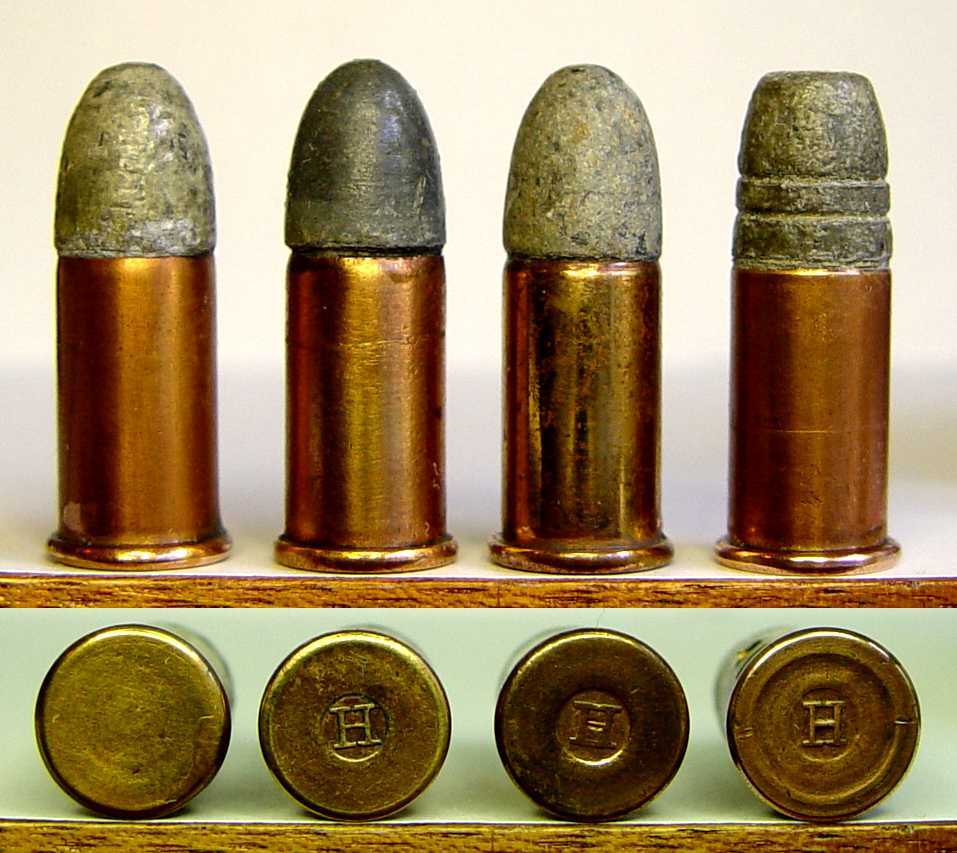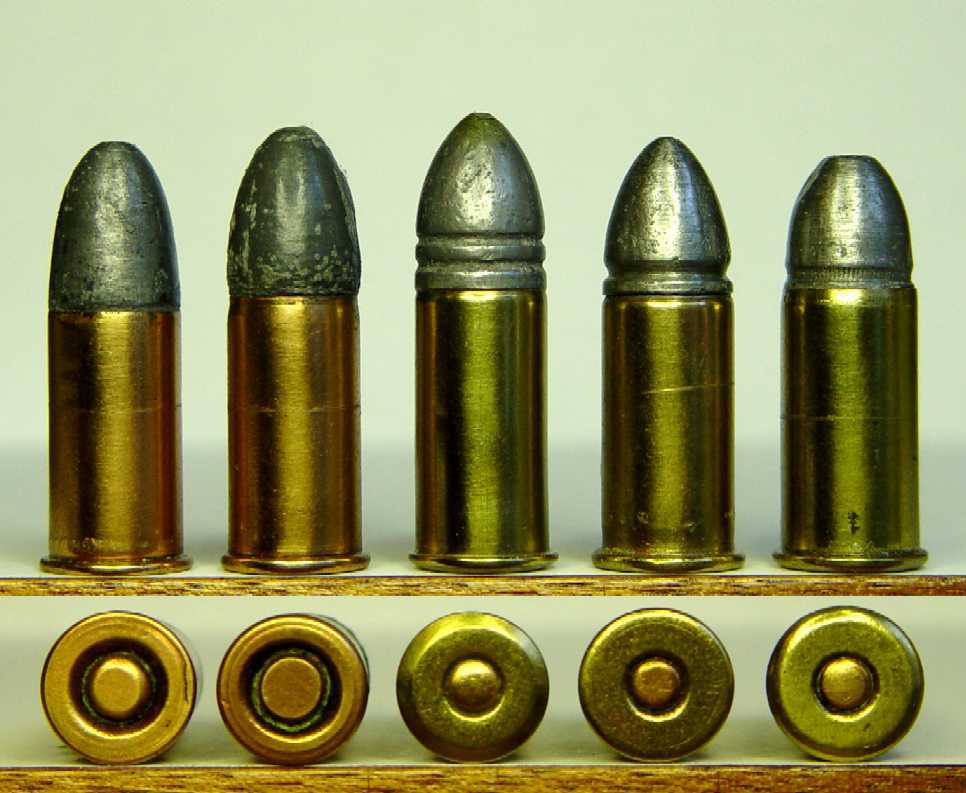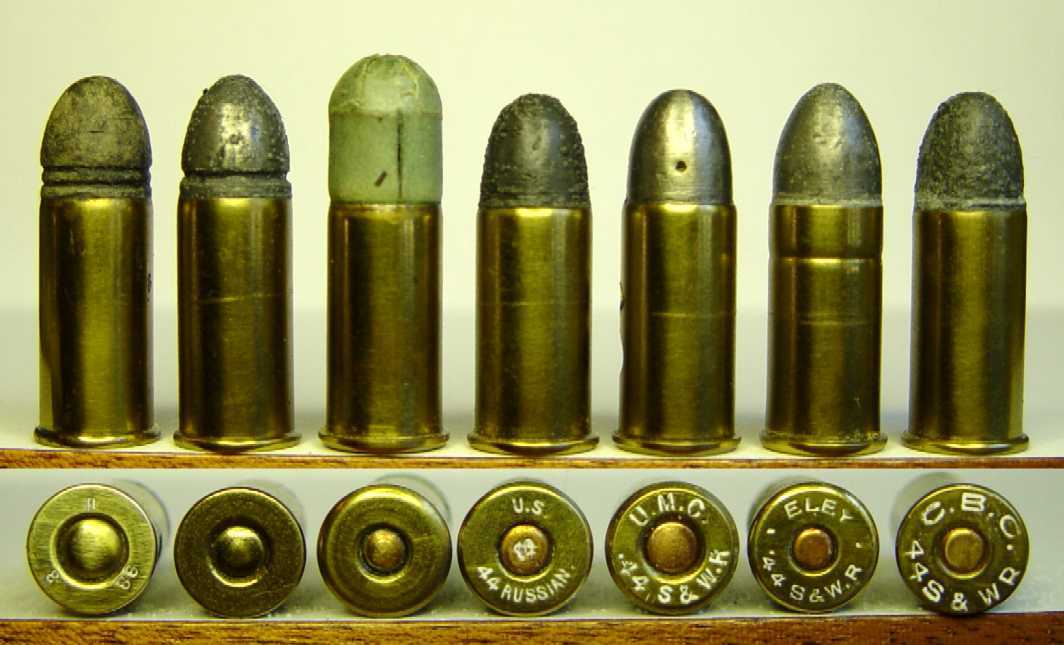| Contents
Home
General
Info
Ordering
Info
Cartridge
Lists
Patent &
Miscellaneous
US Rim Fire
US Center Fire
Pistol
US Center Fire US Rifle
Metric
British
Shotgun Shells
Posters
This Month's Picture Page
Links to Other Sites
Cartridge Collectors Organizations:
IAA
ECRA
SAAACA
Auctions:
Auction
Arms
E-Bay
Ward's Collectibles
Sold USA
Books:
Armory
Publications
WCF Publications
Other Collectr's Sites:
Curtis Steinhauer
E-mail the Ammo Guy |
Home of the Old Ammo Guy's Virtual
Cartridge Trading Table
Featuring a wide range of antique,
obsolete, and modern ammunition for collectors
Picture
Page
September 2004
An early group of .44 Henry
cartridges.....
 At
least three of the .44 Henry rimfire cartridges shown here were made by the
New Haven Arms Company, makers of the Henry repeating rifle, and predecessor
to the Winchester Repeating Arms Company. The first three cartridges are the
early style pointed bullet, having no grooves on the exposed surface. The
first two have a segmented neck crimp to hold the bullet in place. This
style neck crimp was applied using a 4 section tool which squeezed the case
neck around the bullet, leaving four visible 'pinches' in the copper spaced
90 degrees apart around the neck. This was the first neck crimp used by the
New Haven Arms Company when they began production of ammunition for their
Henry rifle in 1860. Two employees of the company, Darwin Ellis and George
Stetson, developed and patented an improved method for forming the neck
crimp in 1865, which involved spinning the cartridge and forcing it against
a fixed die which turned the copper at the edge of the case mouth in against
the bullet. The result was a smooth crimp without the segments. As
Winchester Repeating Arms Company was not formed until 1866, this would mean
that all the rimfire cartridges made by Winchester should have the turned
crimp, and the segmented crimp cartridges should all be New Haven Arms
Company production. The second cartridge has both the segmented crimp and
the raised 'H' headstamp, evidence that both companies utilized this
headstamp. The third cartridge has a turned crimp, and could have been made
by either company. The last cartridge has a bullet style that is usually
attributed to the New Haven Arms Company. It has a turned crimp, and an
unusual multilevel head profile. At
least three of the .44 Henry rimfire cartridges shown here were made by the
New Haven Arms Company, makers of the Henry repeating rifle, and predecessor
to the Winchester Repeating Arms Company. The first three cartridges are the
early style pointed bullet, having no grooves on the exposed surface. The
first two have a segmented neck crimp to hold the bullet in place. This
style neck crimp was applied using a 4 section tool which squeezed the case
neck around the bullet, leaving four visible 'pinches' in the copper spaced
90 degrees apart around the neck. This was the first neck crimp used by the
New Haven Arms Company when they began production of ammunition for their
Henry rifle in 1860. Two employees of the company, Darwin Ellis and George
Stetson, developed and patented an improved method for forming the neck
crimp in 1865, which involved spinning the cartridge and forcing it against
a fixed die which turned the copper at the edge of the case mouth in against
the bullet. The result was a smooth crimp without the segments. As
Winchester Repeating Arms Company was not formed until 1866, this would mean
that all the rimfire cartridges made by Winchester should have the turned
crimp, and the segmented crimp cartridges should all be New Haven Arms
Company production. The second cartridge has both the segmented crimp and
the raised 'H' headstamp, evidence that both companies utilized this
headstamp. The third cartridge has a turned crimp, and could have been made
by either company. The last cartridge has a bullet style that is usually
attributed to the New Haven Arms Company. It has a turned crimp, and an
unusual multilevel head profile.
An assortment of .44 S&W Americans and an
unknown.....

If I had to name one thing that I find most interesting in this hobby, I'd
have to say its the unheadstamped cartridges. With all the information
available today, the headstamped cartridges are usually fairly easy to
identify. Its the unmarked cartridge that provides the biggest challenge,
and which can start my heart pounding when I suspect it may have found a
rare one. The cartridges in this picture were made for use in the Smith &
Wesson Model 3 American revolver, of which approximately 28,000 were
produced between 1870 and 1874. One thousand of these were delivered to the
U.S. Army in March of 1871, the first true cartridge revolver purchased by
the Army. Until the adoption of the Colt Single Action Army revolver in 1873
as the standard sidearm for the US Army, these 1000 S&W American revolvers,
plus a mix of converted Civil War percussion Colts and Remingtons, served
the needs of the Army. The two copper cased, Martin primed cartridges on the
left were produced at the government arsenals in 1871 for use in the military
S&W Americans revolvers. The shorter of the two was made at the National
Armory in Springfield, Massachusetts; the other was made at the Frankford
Arsenal in Philadelphia. The third cartridge with the long two grooved
bullet was probably made by the American Metallic Cartridge Company. The
next cartridge, with its single, wide grooved bullet and small copper
primer, may have been made by the Phoenix Metallic Cartridge Company. The
last cartridge doesn't really fit in here, except that it was identified in
error as a .44 S&W American in a collection I purchased. Dimensions are:
bullet - .428 "(measured at the case mouth), neck - .453", base - .456",
rim - .512", case length - .918, and length overall - 1.360"
This one seems to fit within the wide variance in the dimensions Jacob
Brandt lists for the .44 S&W Russian in his book Manual of Pistol and
Revolver Cartridges, I'm going to assume that is what this one is unless
someone can convince me otherwise.
And speaking of .44 S&W Russians.......

The Smith & Wesson Model 3 Russian revolver was the result of changes made
to the Model 3 American 1st Model revolver at the request of the Russian
military attache, General Alexander Gorloff. The first contract with Russia
for 20,000 revolvers was signed on May 1, 1871. Between this date and 1878,
over 130,000 revolvers were produced for the Russian government, plus
another 50,000 or so that were sold commercially and to the governments of
Turkey and Japan. I've included an assortment the US and foreign cartridges
for this revolver in the picture. The first example on the left with its 2
grooved outside lubricated bullet is a true 'Russian' .44 Russian,
headstamped 'n 8 83', the 'n' being the Cyrillic character for 'P',
indicating the cartridge was made at the Petersburg government arsenal at St
Petersburg. The second cartridge, which has no headstamp, was probably made
by Winchester in the 1870s, and has a single grooved outside lubricated
bullet. Next is another unheadstamped cartridge, this one a multi-ball load
made by the Phoenix Metallic Cartridge Company. Its green paper sabot
contains three lead balls. The remaining cartridges all are later production
with inside lubricated bullets. The first of these was made by the United
States Cartridge Company. The more common .44 Russian cartridges by this
company are headstamped 'U.S.' or 'U.S.C. Co. 44 S & W.R.'; this one with
'RUSSIAN' spelled out is a more difficult headstamp to find. The next one
was made by the Union Metallic Cartridge Company, and has a 'self
lubricating' bullet, recognizable by the three holes in the bullet, through
which grease is forced as the bullet moves down the barrel. Technically, I
suppose this one might be considered to be an outside lubricated bullet. The
next two are of foreign manufacture, the first made by Eley of London, and
the second made by Compania Brasileria de Cartuchos S.A. of Sao Paulo,
Brazil.
|

 At
least three of the .44 Henry rimfire cartridges shown here were made by the
New Haven Arms Company, makers of the Henry repeating rifle, and predecessor
to the Winchester Repeating Arms Company. The first three cartridges are the
early style pointed bullet, having no grooves on the exposed surface. The
first two have a segmented neck crimp to hold the bullet in place. This
style neck crimp was applied using a 4 section tool which squeezed the case
neck around the bullet, leaving four visible 'pinches' in the copper spaced
90 degrees apart around the neck. This was the first neck crimp used by the
New Haven Arms Company when they began production of ammunition for their
Henry rifle in 1860. Two employees of the company, Darwin Ellis and George
Stetson, developed and patented an improved method for forming the neck
crimp in 1865, which involved spinning the cartridge and forcing it against
a fixed die which turned the copper at the edge of the case mouth in against
the bullet. The result was a smooth crimp without the segments. As
Winchester Repeating Arms Company was not formed until 1866, this would mean
that all the rimfire cartridges made by Winchester should have the turned
crimp, and the segmented crimp cartridges should all be New Haven Arms
Company production. The second cartridge has both the segmented crimp and
the raised 'H' headstamp, evidence that both companies utilized this
headstamp. The third cartridge has a turned crimp, and could have been made
by either company. The last cartridge has a bullet style that is usually
attributed to the New Haven Arms Company. It has a turned crimp, and an
unusual multilevel head profile.
At
least three of the .44 Henry rimfire cartridges shown here were made by the
New Haven Arms Company, makers of the Henry repeating rifle, and predecessor
to the Winchester Repeating Arms Company. The first three cartridges are the
early style pointed bullet, having no grooves on the exposed surface. The
first two have a segmented neck crimp to hold the bullet in place. This
style neck crimp was applied using a 4 section tool which squeezed the case
neck around the bullet, leaving four visible 'pinches' in the copper spaced
90 degrees apart around the neck. This was the first neck crimp used by the
New Haven Arms Company when they began production of ammunition for their
Henry rifle in 1860. Two employees of the company, Darwin Ellis and George
Stetson, developed and patented an improved method for forming the neck
crimp in 1865, which involved spinning the cartridge and forcing it against
a fixed die which turned the copper at the edge of the case mouth in against
the bullet. The result was a smooth crimp without the segments. As
Winchester Repeating Arms Company was not formed until 1866, this would mean
that all the rimfire cartridges made by Winchester should have the turned
crimp, and the segmented crimp cartridges should all be New Haven Arms
Company production. The second cartridge has both the segmented crimp and
the raised 'H' headstamp, evidence that both companies utilized this
headstamp. The third cartridge has a turned crimp, and could have been made
by either company. The last cartridge has a bullet style that is usually
attributed to the New Haven Arms Company. It has a turned crimp, and an
unusual multilevel head profile.
